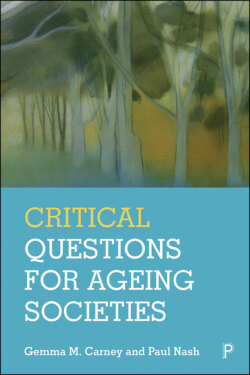Читать книгу Critical Questions for Ageing Societies - Carney Gemma - Страница 10
На сайте Литреса книга снята с продажи.
ОглавлениеPreface
From our first discussions of undertaking a book project, we were determined to produce a book which was informative, easy to read and provided students with answers to the questions that most interest them. Textbooks have tended to follow a well-worn path, focusing on health and social care, the family life of older people and services aimed at them. By choosing to base our book on questions put to us by our students we have chosen a different, perhaps more risky, path. In taking this approach, we have made some progress in shedding new light on areas of research and study which are often ignored in textbooks about ageing and older people. We are particularly pleased that this book includes in-depth discussions of diversity, masculinity and cultural gerontology. However, we are confident that this decision gives what follows greater relevance and timeliness. Most importantly, you can rest assured that answering our students’ questions has produced an interesting read. However, by choosing to follow the interests of our students, based in Leonard Davis School of Gerontology, University of Southern California, US, and Queen’s University Belfast, Northern Ireland, UK, we have, inevitably, had to make some difficult choices, which have resulted in a few compromises.
We acknowledge that our coverage of health and social care is less comprehensive than students taking vocational degrees in health and allied services might expect. Likewise, where we live (UK and US) and the teaching experience we have, which is in social gerontology, means that we have probably offered too many examples from the UK and the US and too few from Canada, Australia or Asia. This is a conscious choice. We have tried, where possible to include as many international examples as are relevant to the learning outcomes we are striving to reach in each chapter. However, we are cognisant that all research and teaching takes place in a particular cultural and geographical context.
On reflection, we decided that it is best for authors to draw on their own research and experience rather than try to be an expert on areas and cultures which they have neither directly studied nor experienced. Likewise, as we explain in the opening chapter, our book is unashamedly post-structuralist in its approach. We wish it to be an important introductory text from the critical gerontology tradition for all scholars of ageing. So, rather than trying to match other texts on issues such as health and illness, we chose to offer a fuller, more student-centred account of recent developments in critical gerontology, which aim to take our understanding of human ageing above and beyond the physiological. That said, we have tried to be as inclusive, broad-minded and comprehensive as possible, bearing in mind that we are two authors working together, playing to our strengths, rather than a long list of international names submitting individual chapters to a handbook.
Lastly, the bulk of the research and writing for this book took place in 2018 and 2019, in the time before coronavirus/COVID-19. We are aware that, unfortunately, the prospects for human longevity may be compromised by the pandemic and some of the projections in the book, made on the basis of publicly available data, may be affected by the impact of the pandemic. At the time of writing, the catastrophic impact of the virus in terms of fatalities among care home residents in most countries is only beginning to be estimated (see Phillipson, 2020). In terms of social policy, the blanket ageism in many of the policies emerging as the crisis unfolds (see British Society of Gerontology, 2020) serves only to support the book’s central premise, that we all must take a critical perspective on the impacts and opportunities that arise from population ageing. While we cannot yet provide solid data on the coronavirus crisis, we can urge our readers to use the pandemic as a means of understanding how the ageing of our population has fundamentally changed the social, political and health systems of every country in the world.
We hope that in the final analysis, you will find our introductory textbook both a comfort and a challenge; a sort of bookish friend to which you will return again and again as you improve your knowledge of ageing and older people. Likewise, if you are teaching gerontology, then we hope that you find our book, its exercises, quizzes and questions the most obliging and insightful of teaching assistance in your work.
